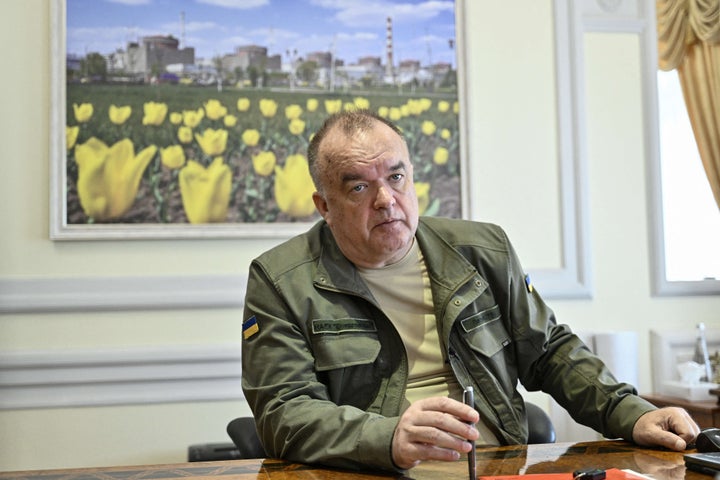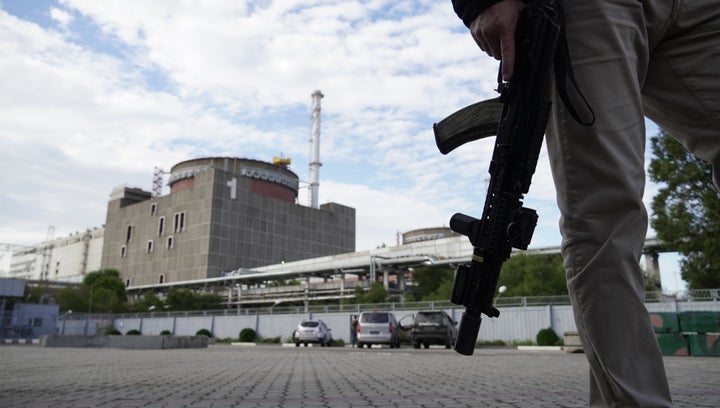In the seven months since Russian forces seized Europe’s largest atomic energy station, Ukrainian engineers have managed to keep the Zaporizhzhia nuclear power plant running safely even as artillery shells repeatedly destroyed the facility’s backup electricity.
But as temperatures drop heading into winter, the risk of a radiation accident is rising, the head of Ukraine’s state nuclear company told HuffPost on Tuesday.
As fighting intensified last month, operators powered down the last of the plant’s six reactors lest another electrical outage jeopardize the cooling systems needed to keep the scorching-hot radioactive material from melting down even when the reactor is idle.
“It was the safest nuclear power plant in Ukraine, and now it is the most dangerous nuclear power plant in the whole world,” said Petro Kotin, president of Ukrainian state-owned nuclear plant operator Energoatom. He spent most of his career working at Zaporizhzhia.
But Energoatom, Ukraine’s state-owned nuclear plant operator, wants to restart at least one of the reactors. A Russian bombing blitz over the last week destroyed 30% of Ukraine’s electrical infrastructure, spurring widespread blackouts. And the neighboring towns where Zaporizhzhia’s workers live have no other source of warmth in the winter besides a district heating system hooked up to the power plant.
Restarting a reactor is also a matter of safety at the plant. There’s a limited amount of diesel to run the generators that provide the last-resort power to keep the plant’s cooling system running — running heaters to keep the storage tanks containing refueling water would only drain the supply sooner.
“Even before we de-occupy the plant, because of the decrease in temperature, we need just to start this one unit to supply steam for heating purposes of the plant itself,” Kotin said dressed in dark green military fatigues as he spoke to HuffPost for 80 minutes over Microsoft Teams from his office in Kyiv, roughly 400 miles northwest of Zaporizhzhia.
Then there are the fish. Zaporizhzhia collects water for its cooling system from an outdoor pond, which operators stocked with an imported fish species to eat algae that could otherwise gum up the reactor turbines. A running reactor expels warm water into the pond, keeping temperatures above 60 degrees Fahrenheit at all times — and, by extension, keeping the Egyptian fish alive. With no reactors running, water temperatures would eventually drop below 50 degrees, Kotin said.
“All the fish will be killed by this cold temperature,” said Kotin.
After that, the plant would have up to 2,000 tons of dead fish to deal with.
“It’s getting cold,” Kotin said. “And some problems arise there, with the functionality of the plant, with the fish that help keep the pond good, and with the condition of people living in the neighboring town, where the heat is all generated by the plant.”

Four high-voltage cables link Zaporizhzhia to the Ukrainian grid, while another low-voltage backup line runs to a nearby coal-fired power plant. Artillery fire repeatedly severed those connections as Ukrainians and Russians blamed each other for indiscriminate shelling, disrupting the plant’s operations at least 15 times since the occupation began in March. But on Aug. 25, the station was cut off from outside power sources for the first time, forcing its operators to rely on Zaporizhzhia’s 20 diesel generators to keep electricity flowing to the cooling systems.
After more than three hours without electricity, Kotin said, a partial meltdown akin to what happened in Fukushima, Japan, in 2011 would likely begin.
Engineers restored the low-voltage line in less than a day and eventually reconnected the plant to the grid. But bombardments have destroyed substations and power lines at least twice more since then, according to Kotin.
Meanwhile, he said, the coal plant no longer has fuel. And Russian artillery destroyed one of the lines connecting Zaporizhzhia to Ukraine’s grid as recently as Monday, leaving the plant dependent on the diesel generators. The facility typically only stores enough diesel to run the generators for 10 days. To preserve fuel, plant operators started running no more than seven generators at a time, which could conserve enough fuel to keep the power on for up to 17 days, Kotin said.
Russian and Ukrainian officials allowed shipments of diesel fuel last week that could give Zaporizhzhia another two full days of generator use. But Kotin saw the rare moment of cooperation as a sign the Russians were “prepared to continue this practice” of cutting the plant off from the power grid.
It’s part of what Ukrainian officials say is a strategy to steal Zaporizhzhia permanently, a power plant worth $30 billion and whose eponymous home province Russian President Vladimir Putin illegally annexed into Russia late last month.

The Ukrainian government believes Russian plans to cut Zaporizhzhia off from the Ukrainian grid and connect the plant to the power system in Crimea, the Ukrainian province Russia conquered in 2014. But doing so would require building huge towers and power lines running over the very Crimean bridge that exploded earlier this month, George Moore, scientist-in-residence at the James Martin Center for Nonproliferation Studies, told Grid. Plus, Russians would need a small army of new nuclear engineers and scientists to run the facility.
“They don’t have the people to operate that plant,” Moore told the news website, warning it would take thousands of workers to restaff the facility.
This month, Russian officials threatened to fire Energoatom employees who don’t sign new contracts to work for Rosatom, Russia’s state-owned nuclear operator. Losing their jobs would likely make the workers eligible for the Russian military draft. Senior employees at the plant, meanwhile, have faced kidnappings, beatings, and alleged torture, and at least two workers have been killed by Russian forces.
“It’s getting cold. And some problems arise there, with the functionality of the plant, with the fish that help keep the pond good, and with the condition of people living in the neighboring town, where the heat is all generated by the plant.”
- Ukrainian nuclear agency chief Petro Kotin
An International Atomic Energy Agency team arrived in late August at Zaporizhzhia to monitor the situation. Since then, the United Nations’ nuclear watchdog has been negotiating to create a demilitarized zone around the plant.
So far, the Russians have refused to pull back as they stepped up targeted strikes in recent weeks on vital civilian infrastructure across Ukraine. Instead, Russians have stationed 50 military vehicles and at least 500 troops at the facility, Kotin said, including a contingent of Chechen soldiers loyal to Chechnya’s regional strongman, Ramzan Kadyrov. A close adviser to Putin, Kadyrov has publicly encouraged the Kremlin to use a small-scale tactical atomic weapon against Ukraine.
The threats of the first wartime nuclear attack since 1945 and the worst atomic power plant accident since Fukushima have, ironically, come at just the moment when nuclear energy looks poised to reverse decades of decline and make a comeback.
Fission reactors produce 24/7 bounties of electricity like fossil fuels, without climate-changing emissions or reliance on constantly-supplied pipelines. Since Russia cut off gas exports to Ukraine’s allies, countries like the Netherlands and Sweden have vowed to build new reactors. Japan and the U.S. are looking to restart shuttered plants, and even anti-nuclear Germany is postponing plans to close its last three generating stations.
Energoatom is hoping to build as many as nine new reactors in the years ahead, ideally, with American or European technology, Kotin said. In July, Ukraine began the process to license U.S. nuclear giant Westinghouse’s AP-1000 reactors, the large-scale machines set to debut soon at Georgia’s Plant Vogtle after years of delays and billion-dollar cost overruns.
The U.S., Kotin said, needs to get past the problems with constructing the first major AP-1000 project and build more reactors. But he admitted that the fate of a global nuclear power resurgence might rest in the hands of Zaporizhzhia’s Ukrainian engineers.
“The renaissance of civilian nuclear power would not survive this additional disaster, which could happen at the Zaporizhzhia nuclear power plant,” Kotin said. “So we need to do everything just to bring Zaporizhzhia to a safe stage and to make all the measures which are required for the safe operation of the plant.”

